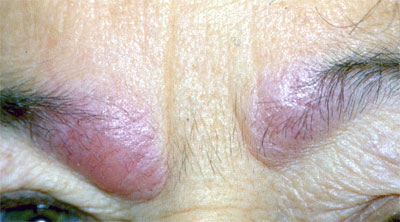|
|
|
Lymphoma-leukemia involvement of the skin
Involvement of the skin with lymphoma cells is quite common, particularly in the case of a T-cell lymphoma.
Indeed, mycosis fungoides and SÚzary syndrome initially present as a cutaneous eruption.
Like T-cell lymphomas, T-cell leukemias frequently have skin involvement. This involvement may manifest itself as a diffuse erythroderma, such as is seen in SÚzary syndrome.
Alopecia mucinosa, involvement of the hair follicles by lymphoma with associated mucin deposition, can be a presenting feature of T-cell lymphoma.
B-cell lymphomas can also involve the skin, with Hodgkin's disease being the most common. B-cell lymphoma involvement of the skin is usually manifested by the development of one or more red-brown nodules. The nodules may ulcerate, or may, as they clear in the center and spread peripherally, form arcuate lesions.
Other lymphocytic and myeloid leukemias can have cutaneous manifestations.
Among the most common of these are the plum-colored infiltrations of the facial skin produced by monocytic or myelomonocytic leukemia which can produce a leonine facies.
Involvement of the skin can be a presenting feature in myelomonocytic leukemia, although it generally occurs late in the course of the disease.
It is important when assessing a solitary nodule that has been histologically called lymphoma, in the absence of any definable systemic disease, to consider the benign cutaneous lymphoid infiltrates in the differential diagnosis.
Similarly, extensive involvement with histologically "benign" lymphocytoma cutis, should suggest the possibility of a true lymphoma.
Treatment:
- early T cell lymphomacan be treated by UVB and PAVA
- Localised lesions can be cleared by electron beam therapy.
- Acitretin has shown inprovement.
- More advanced disease may require methotrexate, other chemotherapeutic agents or photophoresis
- If not responding to systemic chemotherapy, the skin lesions of leukemia and lymphoma, being very radiosensitive, respond very well to radiation therapy.

Back to Dermatology Glossary - L Index |
Back to Dermatology Glossary Index
|